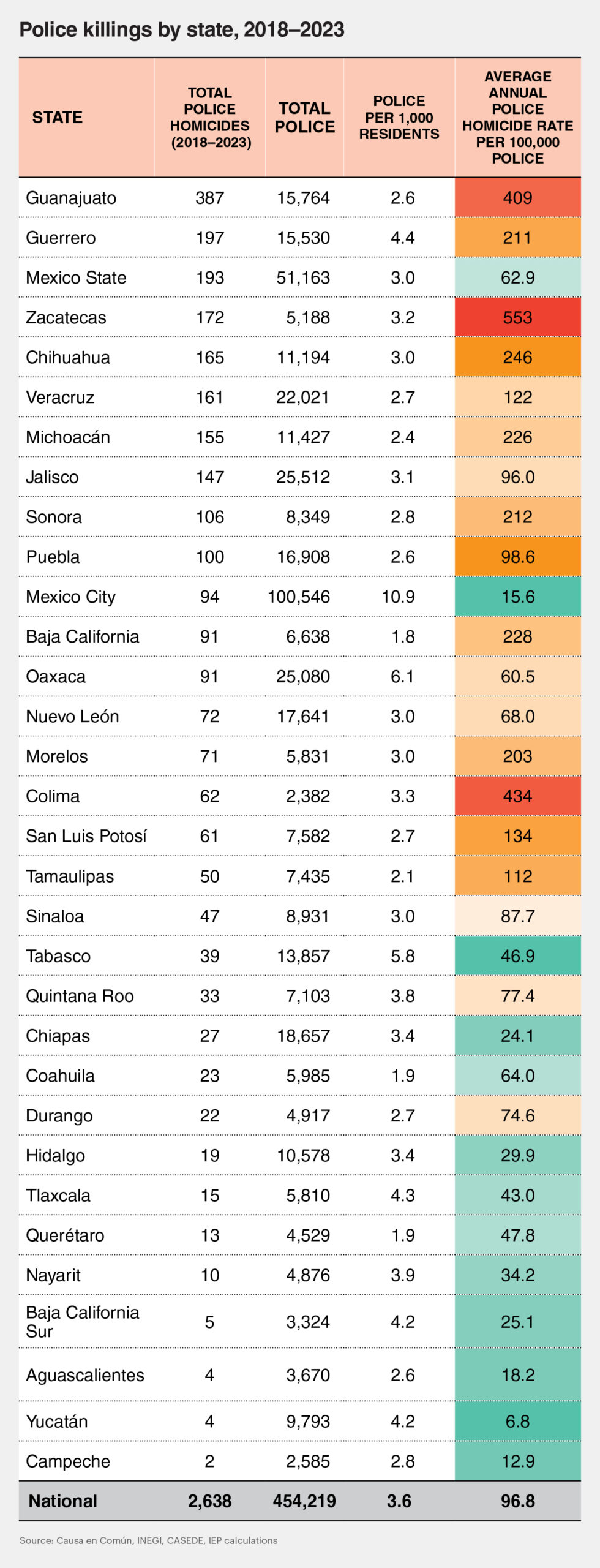This year, Mexico has seen at least 122 police murders. This violence, however, has not affected all regions of the country equally. According to data from the organisation Causa en Común, which maintains records of police murders, the central state of Guanajuato has been the scene of the greatest violence against police officers in the country, with more than a quarter of all the country’s murders in 2024. Analysts have attributed this type of violence to the ongoing conflict between drug cartels – and against the authorities – for territorial control and impunity to carry out their illicit activities.
Despite this grim reality, nationwide police killings in 2024 appear to be on the decline in comparison with recent years. As we detail in the most recent edition of the Mexico Peace Index, released last week, particularly high levels of violence against the police occurred in the period between 2018 and 2023. In total, more than 2,600 officers were killed in those six years, with at least 412 in 2023. The following table shows the number of police deaths across Mexico over those years.

The table further outlines the estimated size of each state’s total police force, comprising municipal police forces, state police forces, and members of the National Guard deployed in each state. On this basis, it also includes estimates on the number of police per 1,000 inhabitants and the average annual police homicide rate by state since 2018.
Between 2018 and 2023, Guanajuato experienced by far the most police homicides of any state, with at least 387 officers killed. It is followed by Guerrero, Mexico State, Zacatecas, and Chihuahua, each with more than 160 officers killed. In contrast, Campeche, Yucatán, and Aguascalientes in total recorded just ten police homicides between 2018 and 2023.
The true lethality of work as a police officer, however, is perhaps better understood in terms of police homicide rates. Against a national police force of over 450,000 officers, the more than 2,600 police killings recorded over the past six years equates to an estimated annual police homicide rate of 96.8 deaths per 100,000 officers. This suggests that being a police officer in Mexico is nearly four times as dangerous as being a member of the general public.
Moreover, in certain states, the dangers associated with police work are considerably greater. While Guanajuato ranks first in terms of total officers killed, it ranks third in terms of the rate of police killings. As a proportion of the overall police force and relative to the overall population of the state, Zacatecas ranks as the most dangerous place to serve as a police officer. Zacatecas has an average annual police homicide rate of 553, meaning that officers in the state have had about a 0.55 per cent chance of falling victim to homicide each year since 2018. This is nearly nine times higher than the average 2018-2023 homicide rate for the general public in Zacatecas.
In the past several years, Zacatecas has been a key battleground in the bloody multi-state conflict between the CJNG, the Sinaloa Cartel, and their respective allies. With the state’s highways being of particular importance for the transportation of drugs northward to the United States. Across Mexico, these groups have repeatedly shown themselves willing to target government security forces in pursuit of heightened influence.
Strikingly, so far in 2024, Zacatecas has not recorded any police homicides, according to Causa en Común records. But the state experienced 32 police killings in 2023, down from a high of 60 the previous year. The state’s deadliest attack on police in 2023 involved five officers kidnapped by an armed criminal group in the small municipality of Villa Hidalgo in early August. The officers were found dead a week later.
In contrast, police officers in Yucatán – the most peaceful state in Mexico – face the lowest police homicide rate in the country. Based on homicide rates alone, it is safer to be a police officer in Yucatán than it is to be an average citizen in Mexico. The state’s police homicide rate of 6.8 falls far below the national homicide rate for the general public. However, Yucatán’s police homicide rate is still substantially higher than the state’s overall homicide rate, which has on average been just 2.1 deaths per 100,000 people since 2018.
In the past six years, police have not fallen victim to homicidal violence at equal rates across all police forces. In both relative and absolute terms, municipal police forces have seen the most officers killed, with more than 1,400 deaths, representing 53.8 per cent of the total. While in most states municipal police forces represent the largest share of the total officers, nationally their membership accounts for only about a third of the total police force. After municipal forces, state police forces have experienced the most killings, with more than 1,050 deaths, representing 39.9 per cent of the total. State police are the second largest overall force in most states, and they account for nearly half of the total national police force, though more than two-fifths (about 95,000 officers) of all state-level police operate in Mexico City alone. Finally, federal-level police, which since 2019 have formed part of the National Guard, have experienced the fewest fatalities, with about 170 deaths, representing 6.3 per cent of all police killings since 2018. National Guard members account for about one fifth of the national police force.
Violence against police officers not only impacts the officers themselves and their families but has consequences for the entire society. In addition to undermining public safety by weakening law enforcement’s ability to protect citizens, it can have a demoralising effect on police forces, affecting officers’ willingness to confront crime, as well as officer retention and recruitment of new members. The killings also represent a direct attack on the rule of law, challenging the authority of the state and eroding trust in its institutions.